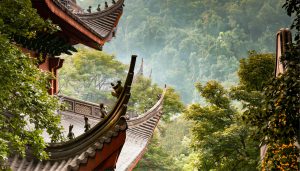China, a country like a continent, is certainly underrepresented within the available space in arboretum Group 37. China has been a relatively closed country for much of its history, and very little was known in the West about its abundant tree species and forest types when the arboretum was founded. Only gradually, as our knowledge of the country expanded, did we come to know China’s extraordinary botanical wealth. Many of China’s endemic species turned out to be spectacular because of their prehistoric appearance or their remarkable ornamental value. To cite just a few examples: Ginkgo biloba, Dawn redwood, Cathay silver fir, Cunninghamia, the Handkerchief tree, and the Golden larch. Starting in the 1960’s a series of attempts were made by U. Liénard, the former director of the arboretum, to give this group a more coherent geographical and logical arrangement – an effort that continues to this day. Subgroup 37A aims to provide a picture of the temperate deciduous forests of Hebei province, where various types of mixed-oak forest with species such as Eastern white oak, Mongolian oak, Chinese cork oak, and Japanese emperor oak mingle with Chinese ash and various types of walnut species. Adding to the richness of these forests are poplar, elm, hornbeam and various maple species. Subgroup 37B represents the mixed mesophytic forest, much closer to a subtropical rainforest of the warmer Zhejiang province. Here we can find a variety of deciduous and evergreen conifers. Subgroup 37C evokes the coniferous forests of the mountains of Sichuan and Shaanxi, with various types of spruce and silver fir. Sadly, the bark beetle plague extinguished these stands in the hot summer of 2019.


